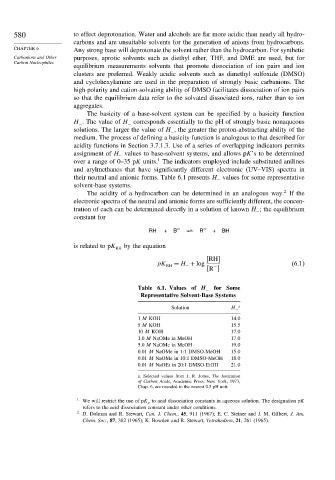Page 598 - Advanced Organic Chemistry Part A - Structure and Mechanisms, 5th ed (2007) - Carey _ Sundberg
P. 598
580 to effect deprotonation. Water and alcohols are far more acidic than nearly all hydro-
carbons and are unsuitable solvents for the generation of anions from hydrocarbons.
CHAPTER 6 Any strong base will deprotonate the solvent rather than the hydrocarbon. For synthetic
Carbanions and Other purposes, aprotic solvents such as diethyl ether, THF, and DME are used, but for
Carbon Nucleophiles
equilibrium measurements solvents that promote dissociation of ion pairs and ion
clusters are preferred. Weakly acidic solvents such as dimethyl sulfoxide (DMSO)
and cyclohexylamine are used in the preparation of strongly basic carbanions. The
high polarity and cation-solvating ability of DMSO facilitates dissociation of ion pairs
so that the equilibrium data refer to the solvated dissociated ions, rather than to ion
aggregates.
The basicity of a base-solvent system can be specified by a basicity function
H . The value of H corresponds essentially to the pH of strongly basic nonaqueous
− −
solutions. The larger the value of H , the greater the proton-abstracting ability of the
−
medium. The process of defining a basicity function is analogous to that described for
acidity functions in Section 3.7.1.3. Use of a series of overlapping indicators permits
assignment of H values to base-solvent systems, and allows pK’s to be determined
−
1
over a range of 0–35 pK units. The indicators employed include substituted anilines
and arylmethanes that have significantly different electronic (UV–VIS) spectra in
their neutral and anionic forms. Table 6.1 presents H values for some representative
−
solvent-base systems.
2
The acidity of a hydrocarbon can be determined in an analogous way. If the
electronic spectra of the neutral and anionic forms are sufficiently different, the concen-
tration of each can be determined directly in a solution of known H ; the equilibrium
−
constant for
RH + B – R – + BH
is related to pK RH by the equation
RH
pK = H +log (6.1)
RH −
R
−
Table 6.1. Values of H for Some
−
Representative Solvent-Base Systems
Solution H_ a
1 M KOH 14 0
5 M KOH 15 5
10 M KOH 17 0
1.0 M NaOMe in MeOH 17 0
5.0 M NaOMe in MeOH 19 0
0.01 M NaOMe in 1:1 DMSO-MeOH 15 0
0.01 M NaOMe in 10:1 DMSO-MeOH 18 0
0.01 M NaOEt in 20:1 DMSO-EtOH 21 0
a. Selected values from J. R. Jones, The Ionization
of Carbon Acids, Academic Press, New York, 1973,
Chap. 6, are rounded to the nearest 0.5 pH unit.
1 We will restrict the use of pK a to acid dissociation constants in aqueous solution. The designation pK
refers to the acid dissociation constant under other conditions.
2
D. Dolman and R. Stewart, Can. J. Chem., 45, 911 (1967); E. C. Steiner and J. M. Gilbert, J. Am.
Chem. Soc., 87, 382 (1965); K. Bowden and R. Stewart, Tetrahedron, 21, 261 (1965).

